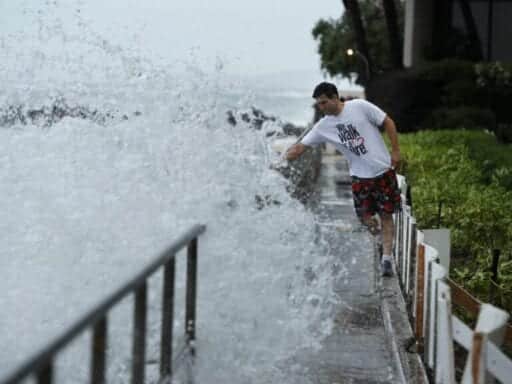The Category 3 storm has already dumped more than two feet of rain on the Big Island.
Hurricane Lane unleashed strong winds and heavy rain on the Hawaiian islands Friday morning, as residents and tourists retreated indoors to wait out the first hurricane to affect the state in 26 years.
According to the National Weather Service, the storm is bringing not just prolonged rainfall, but also flash floods, landslides, damaging winds, and storm surges to the islands, including Oahu and Maui. Forecasters are particularly concerned about rivers that could overflow with deep and fast-moving water, posing a life-threatening risk.
“This will be a long-duration event with the potential for heavy rainfall continuing Sunday into early next week as Lane begins to track westward and away from the state,” the National Weather Service reported Friday.
The storm has already dumped more than 31 inches of rain on the Big Island. Maui Electric, a local utility, warned the storm could bring extended power outages.
This is what Rainbow Falls on the Big Island looks like after more than a foot of rain today. NWS is forecasting heavy rain through the weekend with rates at 1-2 inches per hour at times pic.twitter.com/SrdcdD0SGF
— Brian L Kahn (@blkahn) August 24, 2018
As of Friday morning, the storm had been downgraded to a Category 3 storm, with sustained winds topping out at 120 miles per hour. The latest projection shows the storm moving westward, away from the Hawaiian islands:
/cdn.vox-cdn.com/uploads/chorus_asset/file/12548729/Screen_Shot_2018_08_24_at_10.32.32_AM.png) National Weather Service
National Weather ServiceThough the storm is getting weaker and is not projected to make direct landfall, its pace is slowing down, which means it will continue to dump rain over the islands. The storm still poses a major threat to Hawaii’s 1.4 million residents and the 300,000 tourists currently in the state.
A slowing storm was the key driver behind the record-drenching rainfall in Houston last year during Hurricane Harvey. The storm essentially stalled over the city, dumping 33 trillion gallons of water. Rain gauges reported rainfall higher than 60.58 inches.
Prior to Harvey, the most rainfall ever seen in the United States came from Hurricane Hiki in 1950, which dropped 52 inches of rain in Hawaii. Since 1959, only two other hurricanes have made landfall in Hawaii.
Scientists anticipate that climate change will make hurricanes more severe. Warmer air can hold on to more moisture, which in turn can lead to more torrential rainfall. This contributed to the rainfall from Harvey and the other major hurricanes that struck the United States last year.
Hawaii also faces some unique hazards, like volcanoes. Earlier this summer, Kilauea volcano on Hawaii’s Big Island began spewing ash and gurgling up lava. The eruption has now slowed down, and scientists don’t think the volcano will influence the hurricane or vice versa.
Tracy Gregg, an associate professor of geology at the University of Buffalo, told CNBC that the Kilauea volcano and Hurricane Lane are like ”two monsters passing in a closet. They are really not going to notice each other. They are just going to keep doing what they do.”
How to follow Lane:
- The National Hurricane Center has a page updating every few hours with the latest watches and warnings for Lane. Check it out.
- Follow the Honolulu branch of the National Weather Service on Twitter.
- Follow the Capital Weather Gang’s Twitter account. These folks tend to live-tweet storm updates.
- Here’s a Twitter list of weather experts via meteorologist Eric Holthaus. These experts will give you up-to-the-second forecasts and warnings.
Author: Umair Irfan



